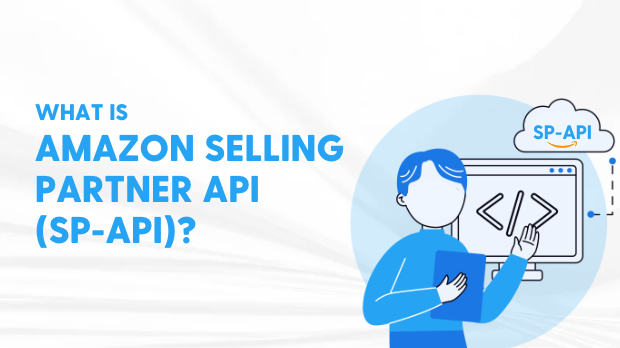Introduction
Amazon sellers and vendors use Amazon APIs to develop customized reporting and task solutions for their businesses. As Amazon’s business metrics, such as inventory levels, fees, and pricing, are subject to frequent changes, the Amazon API provides this information to merchants to enable them to make informed decisions regarding price modifications and inventory restocking.
The Selling Partner API (SP-API) is a modernized set of REST APIs that adheres to the latest development standards. Amazon intends to deprecate the Marketplace Web Services (MWS) APIs by March 31, 2024, but the SP-API upgrade and tools will facilitate the migration of existing MWS connections for developers.
Background
Amazon initially introduced an early version of MWS in 2002, and it has since proved to be a powerful tool for sellers over the past two decades. However, MWS architecture’s reliance on SOAP APIs, and the use of flat-file downloads, can be considered outdated and not up to modern-day standards. Despite Amazon’s reliance on patching and updates to the MWS APIs to meet sellers’ demands, a more innovative approach is necessary to keep up with the evolving needs of Amazon’s sellers.
The MWS APIs have traditionally relied on the exchange of XML documents and flat-file downloads for critical reports in the Amazon Seller Marketplace. However, this architecture presents several issues in various areas, including-
- Authentication: The current model of generating MWS Developer token is not scalable when a seller has 100s of seller accounts across multiple marketplaces.
- Rate Limiting: Rate limiting is essential to ensure the systems are not brought down by bad actors. However, rate limits that are not well-engineered or documented pose many problems to consumers of the APIs.
- Vendor Central data: the current APIs only provide data for the Sellers. There was no recourse other than using the user interface to get their reports for vendors who sell their inventory to Amazon to sell and fulfill.
The Seller Partner API, like MWS, gives developers access to a set of APIs that offer access to their Amazon business-related information. By consolidating Amazon Seller Central and Vendor Central information into cloud data warehouses like Amazon Redshift, Amazon Redshift Spectrum, Google Big Query, Snowflake, and others, the SP-API provides an innovative approach to addressing the challenges MWS APIs pose.
With access to Amazon Seller Central and Amazon Vendor Central information, analysts can turbocharge reporting, analytics, and data visualization using tools like Google Data Studio, Tableau, Microsoft Power BI, Looker, Amazon Quick Sight, SAP, Alteryx, DBT, Azure Data Factory, Qlik Sense, and many others.
Benefits of SP-API
The SP-API provides numerous benefits for sellers, enabling efficient time management through task automation. Many Amazon Seller tools will transition to using the SP-API. However, as legacy MWS sections are phased out, those who do not make the switch will lose access to Amazon order and performance data.
The benefits of Amazon SP-API include:
Improved Discretion and Privacy
Amazon’s new SP-API gives all sellers complete control over what information they want to share with other apps and what information they want to keep private. This provides the seller with greater privacy and control.
Scope of asking for Reviews
With the Solicitations API in the Amazon SP API, sellers may now request reviews and feedback from customers without breaching any terms or conditions. Sellers can make review requests for orders completed between 5 and 30 days ago from their Seller Central account using Amazon’s SP API.
Handle Negative Seller Storefront Reviews
Using the Solicitations API, Sellers can now reach out to customers who have written negative reviews and resolve their issues. This feature helps in improving customer service and brand reputation.
Technical Details
The SP-API is a REST-based framework that operates on the requirements of HTTP methods and primarily uses JSON-based inputs and outputs. For sellers more familiar with MWS, here is a table mapping API from MWS to the Selling Partner API.

With SP-API, you can expect a more modern and efficient approach to API integration.
- Dynamic utilization plans adjust growth fee limits as the enterprise grows. It also provides improvised permissions handling and authentication, enabling sellers to specify granular-level permissions. The API tokens are available through AWS IAM3 after a detailed registration process.
- A sandboxed API model designed for code testing without the need for inventory data.
- New endpoints and support are available in all regions through SP-API.
- SP – API now includes support for Amazon Vendors.
- Amazon offers support for Restricted Data Tokens (RDT) that help safeguard sellers’ Personally Identifiable Information (PII).
API Addons
| API | Function |
| Authorization API | Exchanges MWS authorization token with an SP API LWA authorization code, and offers the RDT. |
| Solicitations API | Lets sellers send solicitations to buyers (seller feedback and product reviews) via the application |
| Messaging API | Lets sellers send messages regarding order delivery, negative feedback removal, etc. |
| Notification API | Notifies the seller when business-relevant events are performed in seller central like the removal of a buy box, changing of product listings, modifications of ASINs, etc. |
| Sales API | Provides sellers with sales performance over time, broken down into time, granularity, and buyer type. |
| FBA Inbound Eligibility API | Allows the seller to view whether their item is eligible for inbound shipment to Amazon’s fulfillment centers in a specific marketplace. |
| FBA Small and Light API | Provides support to sellers to manage their listings in the Small and Light program. |
| FBA Inventory API | Lets sellers participating in the FBA program track their inventory in Amazon’s fulfillment network in real-time at the marketplace level. |
How to get started with SP – API
Daton’s SP-API connector makes it easy to get started with the Amazon Selling Partner API. With this connector, you can quickly and easily connect your Amazon Seller or Vendor account to Daton’s platform and start extracting data. The connector supports all the endpoints available in the SP-API, and it allows you to choose which data you want to extract. Additionally, the connector provides full support for pagination, rate limiting, and error handling, ensuring that you get the data you need in a reliable and efficient manner. With Daton’s SP-API connector, you can start leveraging the power of the Amazon Selling Partner API in no time and gain valuable insights into your business that will help you make better decisions and drive growth.
Top Use Cases of SP – API Connector
- Building P&L Dashboards
SP-API can help build & automate profit and loss (P&L) dashboards to keep track of inventory, sales insights, and returns. - Sales Overview
SP-API can generate dashboards that showcase year-over-year sales, regional sales, organic vs. inorganic sales, and best-selling products by ASIN. To obtain this data, use the FlatFileAllOrdersReportByLastUpdate from the selling partner and subtract ad sales from total sales. - Profit & Loss Statement
The ListFinancialEvents table provides information on Amazon’s commission, promotions fee, taxes, gift wrapping fee, shipping charges, etc. By subtracting these from the net revenue, you can calculate the operational, contribution, and net margins. - Subscription Analysis
By using subscribe and save reports, you can analyze subscription trends and relate them to inventory reports to ensure that you have enough subscription units. - Promotions Analysis
Use the FBAPromotionsReport and PromotionsPerformanceReport to analyze the success of promotions. - Returns Analysis
FBAReturnsReport and FlatFileReturnsReport provide data on the number of returned units and the reasons for their return. - Inventory Analysis
SP-API can help analyze the current availability of stock, determine if inventory needs replenishing for upcoming sales, gauge inventory health, and see out-of-stock rates, days on hand, aged inventory, and sales rank using the FBAInventoryHealthReport. - Business Reports
Business users can get an overview of the brand by obtaining buy box percentage, traffic, sales, and B2B data from business reports. - Fulfilled by Amazon (FBA) Data
SP-API can provide full FBA data from warehouse storage to shipments. - Customer Cohort Analysis
Derive customer cohorts by joining List Orders and FlatFileAllOrdersReportByLastUpdatedDate and analyze purchase patterns. User emails can be obtained from ListOrders since it has both FBA and FBM orders. Finally, date range reports can now be populated in your warehouse using SP-API. - Date Range Reports
SP-API allows sellers to populate date range reports in their warehouses.
Best Practices while using Daton’s SP – API Connector
- Configuration: Some tables like ListFinancialEvents, VATTransactionsReport, and FBARestockInventoryReport need to be configured only once per region. This means that sellers should configure these tables once for each region where they are selling.
- Historical data: When setting up the connector, it is important to set historical data to only when the seller started selling. Otherwise, there will be a lot of jobs trying to fetch data that wasn’t even there. This can slow down data replication and increase the risk of throttling.
- Table selection: Even though the connector has 80+ tables, it is best to configure the tables that are required. This is because there are rate limits that can cause throttling. While Daton now has an advanced rate limit manager that can prevent such errors, increasing the number of tables will slow down data replication to some extent.
- Sales data: When fetching sales data, it is better to use FlatFileAllOrdersReportByLastUpdatedDate rather than business reports. This is because business reports have a delay, the granularity is SKU level in the FlatFileReport, returns are not included in business reports, and order ID is not included in business reports.
Conclusion
Selling Partner API is a game-changer for Amazon sellers and vendors, providing a comprehensive view of their business performance through the consolidation of data from various sources. The use of the SP-API connector turbocharges reporting, analytics, and data visualization, allowing analysts to gain valuable insights and make informed decisions about their business.
At Saras Analytics, we offer a robust and secure SP API connector and over 100 eCommerce connectors to bring all your data into a data warehouse of your choice. Our eCommerce-focused data pipeline, Daton, and custom ML and AI solutions ensure that you always have the right data at the right time. Contact us today for a demo and see how reporting can be supercharged with a 360° view.













